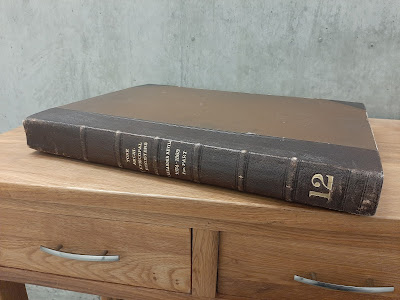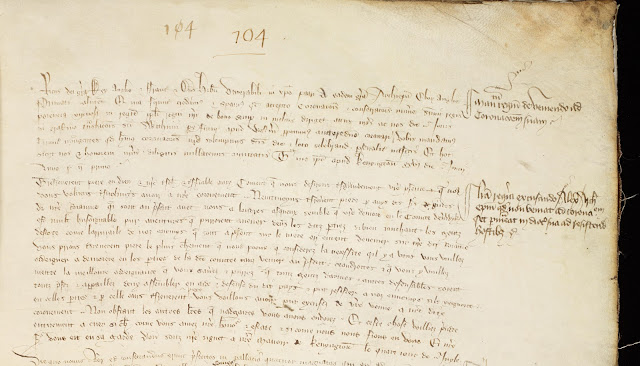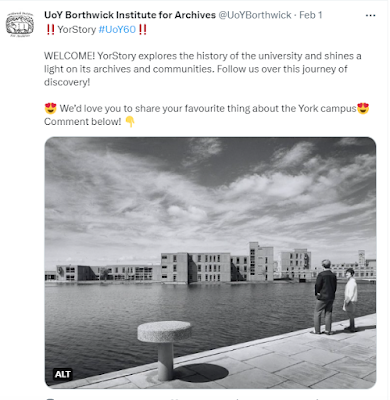As we get ready to celebrate the coronation of King Charles III this weekend, our guest blogger Helen Watt investigates an intriguing set of entries relating to a past coronation, which she found in one of our medieval Archbishops' registers during a recent project.
On 6 May 2023, Charles,
formerly Prince of Wales, will be crowned King Charles III, following the death
of his mother, Queen Elizabeth II, last year. The coronation ceremony will take
place in Westminster Abbey, where kings and queens of England have been crowned
since 1066. Although King Charles is intending to have a shorter ceremony than
that of his mother in 1953, the solemnities will presumably still largely follow
that same order of service which has been used for English royal coronations
since the fourteenth century. Details are found in the Liber Regalis, an
illuminated manuscript belonging to the Abbey, thought to have been created
around 1382, probably for the coronation of Queen Anne of Bohemia, the first
wife of King Richard II.
 |
| Cover of a programme for the coronation of Queen Elizabeth II, 1953, from the author's own family papers. |
The Liber Regalis shows
that the coronation ceremony is performed by the archbishop of Canterbury, with
the bishop of Durham and the bishop of Bath and Wells as supporters of the new
monarch. What then was the role of the archbishop of York in the proceedings?
No particular actions by him are mentioned in the order of service and it seems
likely that the archbishop at the time would simply have been present as the
second highest-ranking member of the clergy alongside the archbishop of
Canterbury. So it is all the more intriguing to find the order of service for
the coronation of a king in the register of Alexander Neville, archbishop of
York, 1374-1388, ‘Ordo coronandi Regem’ (Order of crowning a king).
This entry is found alongside two others relating to the coronation of King
Richard II and a third relating to the manner of performing the coronation of a
king and queen, ‘Qua solemp[nita]te ac sub q[ui]buz m[od]o & for[m]a Rex
& Regina debeant coronari’ (By which solemnity and under what manner
and form a king and queen should be crowned).
All four entries have come to light following successive projects to work on
the registers of the Archbishops of York, 1225-1650, carried out by the Borthwick
Institute for Archives and Department of History at the University of York. The
first of these projects, entitled ‘Archbishops’ Registers Revealed’, completed
between 2014 and 2015 in the Borthwick and generously funded by the Andrew W.
Mellon Foundation, resulted in the digitisation of the registers of the
Archbishops of York, 1225-1650.
It produced high quality images of the registers contained in an online
database and included entries from the register of Archbishop Neville, which
had been indexed as part of the pilot for the project in 2012, also funded by
the Andrew W. Mellon Foundation.
Following on from that project and a subsequent project generously funded by
the Marc Fitch Fund also carried out in the Borthwick between 2015 and 2016 to
index the registers, 1576-1650, ‘The Northern Way’ project, generously funded
by the Arts and Humanities Research Council, ran from 2019 to 2022 and was managed
by the Department of History in partnership with The National Archives, Kew,
and with the support of York Minster.
That project carried out indexing of all the fourteenth century York
Archbishops’ registers, and so further highlighted entries from Neville’s
registers, including those relating to the coronation of Richard II and the
order of service for coronations of a king and a king and queen.
 |
| Registers of Archbishop Neville on the shelves in the Borthwick strongroom, 2023. |
 |
The register of Archbishop Neville containing entries for the coronation of King Richard II.
|
Thinking of the latter two
entries and taking into account the duration of the reign of Richard II, 1377-1399,
and the period during which Neville was archbishop, 1374-1388, could the first
entry relate to the coronation of Richard II in 1377 and predate the Liber
Regalis, and the second, to the coronation of Richard II’s queen in
1382 and follow the Liber Regalis? As we shall see, the answer is not so
simple. The first point to consider is that the initial entry firmly
identifiable with the coronation of Richard II consists of the royal order to
the archbishop, dated 26 June 1377, to attend that coronation, which was to
take place on 16 July 1377 at Westminster Abbey. This order is identical to
that sent out to the archbishop of Canterbury and presumably to all those dignitaries
who were to attend.
However, the second entry in the register consists of a royal letter dated 4
July 1377, excusing Archbishop Neville from attending, for fear of invasions by
the Scots and enemies approaching by sea. These reasons seem to make it very
plausible that the archbishop would not travel to London at that time;
nevertheless he is described as only ever having left his archdiocese during
his first ten years in office, mostly for short spaces at a time to attend Parliament.
The only other period he spent outside his own diocese was to assist in
defending the border with Scotland during threats of invasions in 1383 and
1384, and not in 1377.
Although taxation, specifically two clerical tenths from Canterbury and York,
was to be raised at the very beginning of the reign of Richard II to finance resisting
enemy invasions, this request may well have applied equally to naval attacks
launched by the French, as to invasions by the Scots.
Therefore, it seems very likely that Archbishop Neville was simply not intending
to make the journey to London for the coronation, but to stay in the north,
probably at his palace at Cawood, on which he spent much time and money
improving.
 |
| The first two entries relating to the coronation from the register of Archbishop Neville: the Royal writ of King Richard II ordering the archbishop of York to attend his coronation on 16 July 1377 at Westminster, and copy of a letter of Richard II excusing the archbishop from attending his coronation. |
Following the royal order and
letter are the two entries relating to the order of service for the coronation
of a king and of a king and queen, as already mentioned. These entries are
undated, but are preceded by those noted above, dated in 1377, and followed by
others, also dated in 1377, although not in strict date order.
Does this order in the register suggest that the entries relating to the
coronation service also date from 1377 and so pre-date the coronation of Queen
Anne of Bohemia? If not, could they have been copied into the register, but not
in chronological order? One answer to these questions might be to look at the
overall makeup of the register; as with most of the fourteenth-century
registers of the Archbishops of York, it is divided into various sections and
these entries fall within the section entitled ‘Diverse Letters’. This section
contains entries, as the title suggests, covering a range of subjects, but
generally dated between 1377 and 1384. Certainly, the first few folios of this
section, ff. 100-7, including f. 104 in which the entries relating to the
coronation are found, do appear to be arranged in chronological order between
1377 and 1382, although f. 105r includes an entry containing a copy of a
document dated in 1222, and f. 107r, an entry dated in May 1378, in between
others dated in 1381 and 1382, therefore perhaps out of place. Given this
general arrangement, it is possible to conclude that the coronation entries,
because they appear between entries dated in 1377, may well pre-date 1382, and
so perhaps relate to an earlier period, perhaps to 1377 or before.
 |
| Entries relating to the order of service for the coronation of a king and of a king and queen, found in the register of Archbishop Neville, c.1377. |
Turning back to the Liber
Regalis, as well as existing in manuscript form, as described above, and as
well as having been printed in volume 93 of the series of publications of the
Roxburghe Club, the
manuscript also appears in print, in the original Latin with an English translation,
alongside several other documents relating to coronations of English kings and
queens in another volume, English Coronation Records.
Therefore, these two works provide ample means of comparing the text of the Liber
Regalis with the entries found in Archbishop Neville’s register, in an
attempt to discover the origin of the register entries. The editor of English
Coronation Records also provides details of the recensions, or various
forms which the medieval coronation service took and describes the Liber
Regalis as the fourth recension of the text, the fullest thus far.
The editor was also of the opinion that this particular version was used at the
coronation of King Edward II, which took place in 1308, but only contained
short rubrics or criteria for the service, with more detail included later,
perhaps in the reign of Richard II.
Could this identification of
the text of the Liber Regalis provide further corroboration of the date
of the entries in the archbishop’s register or not? The only way to find out
was to compare the entries with the text of the Liber Regalis, line by
line and word for word. This exercise proved very fruitful and although it
answers the question in part, also raises other points. The results of the
comparison appear to confirm that the register entries only contain the short
rubrics of the coronation service, whereas the Liber Regalis is a much
fuller version of the text. Therefore, it does seem likely that the register
entries predate the more detailed order of service used in the coronation of
Anne of Bohemia, but by how much? The editor of English Coronation Records
also compared the Liber Regalis with another document, a fourteenth-century
Pontifical of Westminster Abbey in the Bodleian Library in Oxford.
Looking at the variations in the text of the Liber Regalis found in the
Westminster Pontifical, it is clear that the entries in the York archbishop’s
register follow those variations very closely, if not exactly, and so the
entries must pre-date the Liber Regalis. Indeed, the editor of a text for
a coronation order of service printed in another volume, Monumenta Ritualia
Ecclesiae Anglicanae, specifically identifies the Westminster Pontifical
variations as relating to the order of service for Edward II.
However, also published in English Coronation Records is a document
entitled ‘Forma et Modus’, which is said to be reminiscent of the rubrics of
the Liber Regalis, but is thought to date from the fifteenth century.
Although the first register entry relating to the coronation contains the words
‘m[od]o & for[m]a’, as noted above, so that the same words appear in the
title and heading of each, the texts do not match and so the register entry may
still relate to an earlier period.
Nevertheless, the register
entries appear to have been copied from another text, since there are evidently
copying errors, where the scribe has missed a line, realised his mistake,
crossed out a few words and started again.
Another aspect of the register entries is that when compared with the Liber
Regalis, they are not in order, but that the first of the entries, relating
to the coronation of a king and queen, noted above, should fall within the
second, relating to the coronation of a king.
Could it be possible that the
register entries were copied from a manuscript belonging to Westminster Abbey,
containing details of the order of service of the coronation, probably for
Edward II, and if so, how and why? If Archbishop Neville rarely left his
archdiocese, did his clerks also stay with him in the north or have access to
manuscripts in the south? Or were there other manuscripts in York archdiocese
containing the recension of the coronation service earlier than that fuller
version thought to have been produced during the reign of Richard II? If the
archbishop had no intention of attending the coronation ceremony, why was the
order of service copied into his register together with the other documents in
the first place? At present, all these questions are intriguing and remain
unanswered, but still show that there was perhaps the same interest in the
coronation of a new king in the late fourteenth century as there will be today.
See F. D. Logan (ed.),
‘The Register of Simon Sudbury, Archbishop of Canterbury, 1375-1381’, Canterbury
and York Society, 110 (Woodbridge, 2020), p. 293, no. 798.
R. G. Davies,
‘Alexander Neville, Archbishop of York, 1374-1388’, Yorkshire Archaeological
Journal, 47 (1975), 87-101 (93).
L. G. Wickham Legg
(ed.), English Coronation Records (Westminster, 1901), XIII, pp. 81-130.


















